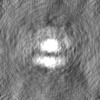+ Open data
Open data
- Basic information
Basic information
| Entry |  | |||||||||
|---|---|---|---|---|---|---|---|---|---|---|
| Title | Clostridioides difficile Transferase B Component Hexamer | |||||||||
 Map data Map data | CDTb hexamer map. | |||||||||
 Sample Sample |
| |||||||||
 Keywords Keywords | Toxin / Clostridioides / Iota / ADP-ribosyltransferase | |||||||||
| Biological species |  Clostridioides difficile R20291 (bacteria) Clostridioides difficile R20291 (bacteria) | |||||||||
| Method | single particle reconstruction / cryo EM / Resolution: 12.05 Å | |||||||||
 Authors Authors | Sheedlo MJ / Mullard RM | |||||||||
| Funding support |  United States, 1 items United States, 1 items
| |||||||||
 Citation Citation |  Journal: PLoS Pathog / Year: 2025 Journal: PLoS Pathog / Year: 2025Title: Oligomerization of the Clostridioides difficile transferase B component proceeds through a stepwise mechanism. Authors: Robin M Mullard / Michael J Sheedlo /  Abstract: Clostridioides difficile is a gram-positive, pathogenic bacterium and is currently the leading cause of hospital-acquired, infectious diarrhea in the United States. During infection, C. difficile ...Clostridioides difficile is a gram-positive, pathogenic bacterium and is currently the leading cause of hospital-acquired, infectious diarrhea in the United States. During infection, C. difficile produces and secretes up to three toxins called Toxin A, Toxin B, and the C. difficile transferase (CDT). While Toxin A and Toxin B are thought to drive the pathology associated with the disease, strains that produce CDT have been linked to increased disease severity, higher rates of infection recurrence, and increased incidence of mortality. A basic understanding of how CDT intoxicates host cells has emerged over the past two decades and includes a framework that relies on the oligomerization of the components that comprise CDT to promote cellular intoxication. Although several key steps of this process have been biochemically described, a clear, molecular description of toxin assembly has not been resolved. We have collected cryogenic electron microscopy (Cryo-EM) data of purified, recombinant CDT. From these data, we have generated several structural snapshots of the toxin, including a series of structures that correspond to intermediates that form during oligomerization. These structures provide insight into the mechanism underlying toxin assembly and highlight a role for structural plasticity during this process. We have also shown that these partially assembled toxins are equally potent in cytotoxicity assays supporting this model in a cellular context. Finally, we show that CDTb oligomers are stabilized by CDTa and assembly is triggered by hydrophobic molecules. | |||||||||
| History |
|
- Structure visualization
Structure visualization
| Supplemental images |
|---|
- Downloads & links
Downloads & links
-EMDB archive
| Map data |  emd_48177.map.gz emd_48177.map.gz | 72.7 MB |  EMDB map data format EMDB map data format | |
|---|---|---|---|---|
| Header (meta data) |  emd-48177-v30.xml emd-48177-v30.xml emd-48177.xml emd-48177.xml | 14.6 KB 14.6 KB | Display Display |  EMDB header EMDB header |
| FSC (resolution estimation) |  emd_48177_fsc.xml emd_48177_fsc.xml | 11.4 KB | Display |  FSC data file FSC data file |
| Images |  emd_48177.png emd_48177.png | 31.2 KB | ||
| Filedesc metadata |  emd-48177.cif.gz emd-48177.cif.gz | 4.1 KB | ||
| Others |  emd_48177_half_map_1.map.gz emd_48177_half_map_1.map.gz emd_48177_half_map_2.map.gz emd_48177_half_map_2.map.gz | 139 MB 139 MB | ||
| Archive directory |  http://ftp.pdbj.org/pub/emdb/structures/EMD-48177 http://ftp.pdbj.org/pub/emdb/structures/EMD-48177 ftp://ftp.pdbj.org/pub/emdb/structures/EMD-48177 ftp://ftp.pdbj.org/pub/emdb/structures/EMD-48177 | HTTPS FTP |
-Validation report
| Summary document |  emd_48177_validation.pdf.gz emd_48177_validation.pdf.gz | 890 KB | Display |  EMDB validaton report EMDB validaton report |
|---|---|---|---|---|
| Full document |  emd_48177_full_validation.pdf.gz emd_48177_full_validation.pdf.gz | 889.6 KB | Display | |
| Data in XML |  emd_48177_validation.xml.gz emd_48177_validation.xml.gz | 20.2 KB | Display | |
| Data in CIF |  emd_48177_validation.cif.gz emd_48177_validation.cif.gz | 26.2 KB | Display | |
| Arichive directory |  https://ftp.pdbj.org/pub/emdb/validation_reports/EMD-48177 https://ftp.pdbj.org/pub/emdb/validation_reports/EMD-48177 ftp://ftp.pdbj.org/pub/emdb/validation_reports/EMD-48177 ftp://ftp.pdbj.org/pub/emdb/validation_reports/EMD-48177 | HTTPS FTP |
-Related structure data
- Links
Links
| EMDB pages |  EMDB (EBI/PDBe) / EMDB (EBI/PDBe) /  EMDataResource EMDataResource |
|---|
- Map
Map
| File |  Download / File: emd_48177.map.gz / Format: CCP4 / Size: 149.9 MB / Type: IMAGE STORED AS FLOATING POINT NUMBER (4 BYTES) Download / File: emd_48177.map.gz / Format: CCP4 / Size: 149.9 MB / Type: IMAGE STORED AS FLOATING POINT NUMBER (4 BYTES) | ||||||||||||||||||||||||||||||||||||
|---|---|---|---|---|---|---|---|---|---|---|---|---|---|---|---|---|---|---|---|---|---|---|---|---|---|---|---|---|---|---|---|---|---|---|---|---|---|
| Annotation | CDTb hexamer map. | ||||||||||||||||||||||||||||||||||||
| Projections & slices | Image control
Images are generated by Spider. | ||||||||||||||||||||||||||||||||||||
| Voxel size | X=Y=Z: 0.86 Å | ||||||||||||||||||||||||||||||||||||
| Density |
| ||||||||||||||||||||||||||||||||||||
| Symmetry | Space group: 1 | ||||||||||||||||||||||||||||||||||||
| Details | EMDB XML:
|
-Supplemental data
-Half map: CDTb hexamer half map A.
| File | emd_48177_half_map_1.map | ||||||||||||
|---|---|---|---|---|---|---|---|---|---|---|---|---|---|
| Annotation | CDTb hexamer half map A. | ||||||||||||
| Projections & Slices |
| ||||||||||||
| Density Histograms |
-Half map: CDTb hexamer half map B.
| File | emd_48177_half_map_2.map | ||||||||||||
|---|---|---|---|---|---|---|---|---|---|---|---|---|---|
| Annotation | CDTb hexamer half map B. | ||||||||||||
| Projections & Slices |
| ||||||||||||
| Density Histograms |
- Sample components
Sample components
-Entire : Clostridioides difficile Transferase Component B
| Entire | Name: Clostridioides difficile Transferase Component B |
|---|---|
| Components |
|
-Supramolecule #1: Clostridioides difficile Transferase Component B
| Supramolecule | Name: Clostridioides difficile Transferase Component B / type: complex / ID: 1 / Parent: 0 / Macromolecule list: #1-#2 |
|---|---|
| Source (natural) | Organism:  Clostridioides difficile R20291 (bacteria) Clostridioides difficile R20291 (bacteria) |
| Molecular weight | Theoretical: 450 KDa |
-Experimental details
-Structure determination
| Method | cryo EM |
|---|---|
 Processing Processing | single particle reconstruction |
| Aggregation state | particle |
- Sample preparation
Sample preparation
| Buffer | pH: 8 |
|---|---|
| Vitrification | Cryogen name: ETHANE |
- Electron microscopy
Electron microscopy
| Microscope | TFS KRIOS |
|---|---|
| Image recording | Film or detector model: GATAN K3 BIOQUANTUM (6k x 4k) / Average electron dose: 50.0 e/Å2 |
| Electron beam | Acceleration voltage: 300 kV / Electron source:  FIELD EMISSION GUN FIELD EMISSION GUN |
| Electron optics | Illumination mode: FLOOD BEAM / Imaging mode: BRIGHT FIELD / Nominal defocus max: 1.5 µm / Nominal defocus min: 0.5 µm |
| Experimental equipment |  Model: Titan Krios / Image courtesy: FEI Company |
+ Image processing
Image processing
-Atomic model buiding 1
| Refinement | Protocol: AB INITIO MODEL |
|---|
 Movie
Movie Controller
Controller


















 Z (Sec.)
Z (Sec.) Y (Row.)
Y (Row.) X (Col.)
X (Col.)





































